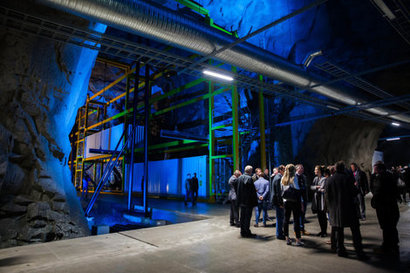
LMD has been constructed 150 metres into a mountain in what was formerly an underground mine for the extrication of olivine, a green material which in its form as a gemstone is known as peridot but which is otherwise used in steel production. The site is located on the west coast of Norway, between Måløy and Nordfjordeid, and consists of a six-storey facility in which the data centre is powered exclusively by locally-produced renewable energy while being cooled by the water from a nearby fjord.
ABB has supplied the data centre’s critical infrastructure. This provides clean energy generated by four glacial hydropower stations and two wind farms, with a combined capacity in excess of 300 MW.
Since opening in May last year, LMD has contracted 10 MW, with 8 MW already in production and the final 2 MW to go live in Q3 2018, when expansion for the next 5 MW will commence. Q4 2018 will see another 5 MW added. LMD have 45 MW redundant capacity on Level 3 but will expand into level 2 and 4 when Level 3 is complete. Level 2 and 4 will both have more than 50 MW redundant capacity.
Data centres are the backbone of our daily life. They store all the data generated by smart devices, businesses and social media. Without them, we wouldn’t be able to check for traffic, or the weather, or see the latest updates of people we follow. Tech firms, large and small, also rely on data centre storage to serve their customers worldwide. Therefore reliability is everything in a data centre. Maintaining secure operations 24 hours a day is crucial, with redundant systems in place to ensure the data centre is always operational.
However, data centres are also among the biggest consumers of energy, yet Lefdal Mine is remarkably energy efficient, because it uses cold water from the 565 meter-deep fjord as a coolant. The data centre is located below sea level, eliminating the need for expensive high-capacity pumps to lift the fjord’s water to the cooling system’s heat exchangers. The result is that the data centre’s cooling solution will have power usage effectiveness (PUE) – the industry standard for energy efficiency - of between 1.08 and 1.15 for 5 kW rack, making it among the greenest data centres in the world with 30-40 percent energy savings over traditional data centres.
“Cooling is crucial, because these servers generate huge amounts of heat” said Mats Andersson, Marketing Director, Lefdal Mine Datacentre. “Because water cooling is so efficient, these server containers can run up to 50 kW of power, where you would normally expect just 7-8 kW with traditional air cooling”.
Andreas Keiger, Executive Vice President, Rittal, added that ABB was one of the first to be involved in the project, because everything starts with power. About 120,000 square metres (1.3 million square feet) of white space is currently available in the data centre, much of it in containers shipped by Rittal and parked in the former underground mine passages.
To meet the powering challenges due to the physical size of the facility, ABB has built a medium-voltage backbone for the entire facility. To meet any emergency situation, ABB also provides a decentralised UPS (uninterruptible power supply) system, which means that each section inside the data centre has its own UPS installation. If there is a problem with the grid, the UPS kicks in within a couple of milliseconds and ensures reliable power supply until the backup generators come online.
ABB has been an integral partner from the beginning of the project, providing tailored power supply solutions and extensive knowledge and expertise for such a challenging engineering project. Providing a powering system that can remain reliable as the centre grows - to 200 MW from the current 10 MW in phases over the next three years - is of particular importance. When its growth is complete, Lefdal will be among Europe’s largest data centres.
LMD has been developed at just the right time, since Norway is currently aiming to become a leader in the development of green data centres. The country has a surplus of renewable energy, since 97 percent of its electricity comes from renewable sources, mainly hydropower. Furthermore, the country’s solar sector is also growing fast – though still currently at less than one percent of power generation, panel installations grew by more than 300 percent in 2016.
The Norwegian government is looking to encourage more digital innovation to create new industries that create jobs and boost economic growth. In February 2018, the government released its data centre strategy ‘Powered by Nature,’ which stressed that attracting data centres and international investments is an important part of their industrial policy. With a fast-growing demand for more data centres powered by renewable energy, LMD will have an edge with its unique location and engineering.
For additional information:

